 Hedvig
Hedvig Lisa Dengler
Lisa Dengler Faustine Lara
Faustine Lara Nhi Py
Nhi Py Lola Mansil
Lola Mansil
Fashion designer Lilly Pulitzer died on Sunday in Palm Beach, Florida, at age 81, her company said.
Pulitzer was known for her bright, cheerful print shift dresses that were popular with socialites and evoked a lifestyle of affluence in Florida and New York's Hamptons resorts.
Her company, named Lilly Pulitzer, also made children's wear, men's wear and household goods, often based on the same prints and bright colors.
"Early this morning, Lilly Pulitzer Rousseau passed away peacefully in Palm Beach, surrounded by family and loved ones," her company said in a statement posted on Facebook. "Lilly has been a true inspiration to us and we will miss her.
"Lilly was a true original who has brought together generations through her bright and happy mark on the world," the statement said.
It did not disclose a cause of death.
Pulitzer's designs were born when she was running a juice stand in Florida and had a sleeveless dress made from colorful printed cotton to hide the juice stains, according to the company website.
She had eloped at age 21 with publishing heir Peter Pulitzer and moved to Palm Beach, "in the shadow of Peter's citrus groves," from New York City, it said. The couple later divorced.
The classic shift dress gained international attention when first lady Jacqueline Kennedy, a former classmate of Pulitzer's, was photographed wearing one of her dresses on vacation, it said.
Her company declared bankruptcy in 1984 but was relaunched in 1992.
She and Pulitzer had three children, according to People magazine. Her second husband was hotelier Enrique Rousseau who died in 1993, according to People.
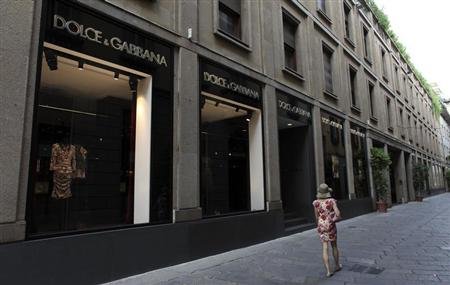
MILAN (Reuters) - Italy's Tax Commission has fined fashion designers Domenico Dolce and Stefano Gabbana 343.4 million euros ($441 million) for tax evasion.
The decision confirmed to Reuters by Italy's tax agency on Tuesday relates to payments the agency says should have been made when the designers sold their D&G and Dolce & Gabbana brands to their own Luxembourg-based holding company GADO in 2004.
The authorities ruled that the designers engineered the transaction to avoid paying taxes in Italy, where corporate tax rates are among the world's highest.
Dolce and Gabbana, known for their Sicily-inspired style, were not available for comment on Tuesday, though they have repeatedly denied any wrongdoing.
"GADO operated as an 'ad hoc' safe, an operation to carry out illicit international fiscal planning aimed at saving taxes," the Tax Commission said in its February ruling, which was filed on March 20 and first surfaced in the Italian media on Saturday.
The designers can ask to have the fine suspended until they exhaust the appeal process.
"The fact is that I didn't do anything!" Gabbana said on Twitter on Saturday.
Fans of the designers voiced their support on Twitter, some encouraging them to leave Italy, others urging them to fight to clear their names.
Dolce and Gabbana are also facing a separate criminal trial in Milan relating to the same case. Neither have yet appeared in court and the trial is expected to continue for months.
Italian authorities have intensified efforts to collect taxes in recent years, targeting groups such as jeweler Bulgari to check whether they have complied with fiscal rules.
Previous tax cases involving celebrities in Italy have led to out-of-court settlements.
In 2000 the late opera singer Luciano Pavarotti paid more than $12 million in back taxes, while former MotoGP world champion Valentino Rossi agreed to pay $51 million to Italy's tax agency in 2008 after a lengthy investigation.
Argentine soccer great Diego Maradona recently denied that he owes Italian authorities 38 million euros in unpaid taxes.
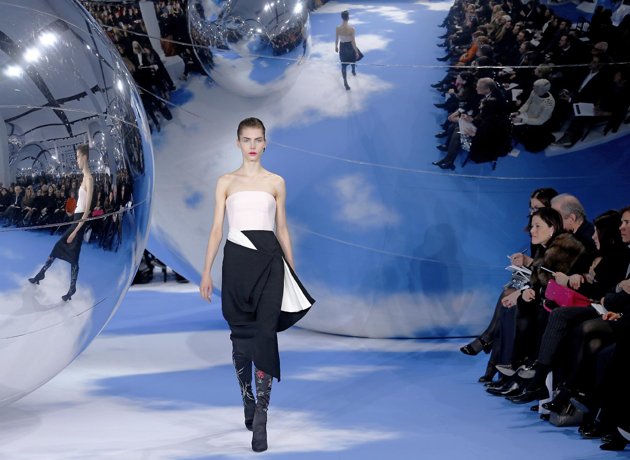
PARIS (AP) — The fourth day of Paris fashion week saw Raf Simons unveil the latest chapter of his journey after nearly a year at the design helm of Christian Dior.
Following his acclaimed debut last year, the pressure has been stacked on the Belgian designer to deliver again in what is only his second ready-to-wear show in one of the most influential jobs in fashion. And Friday saw Simons live up to expectations.
He confidently evolved the angular portions of previous seasons' work into softer, more saleable silhouettes. The new Bar jacket, looser and in trendy wool denim, seemed to point to a man who's finally settled in to his role.
This season was the supplest fusion so far of his minimalism and the house's ultra-femininity and curves.
Fall-winter 2013-14 saw a parade of "memory dresses," some 48 looks that delved into the iconic houndstooth, peplums, and Monsieur Dior's original '40s designs. They hit the catwalk outside Paris' Hotel des Invalides, reimagined, alongside enormous mirror ball decor.
Like thought bubbles, the reflective spheres set the tone for the musing, which included an embroidered tulle bustier A-line dress, an archive piece called "Miss Dior 1949" reworked in hip embroidered black leather. Elsewhere, blown-up houndstooth had a surreal quality, in vertical slices down column silhouettes. It was a great re-working of the classic pattern first used by the house in the late '50s.
The more muted palette of black, white, pale pink and navy was further proof of his evolution. After all, while at Jil Sander, it was Simons who started the bright color trend.
There was plenty of imagination, like prints and embroideries of surreal eyes and tears that resembled ants, reminiscent of Salvador Dali. However, the show could have done without motifs by Andy Warhol, like a sparking stiletto print, which sometimes jarred as overly adolescent, and a tad tacky.
Overall, the show was a success; one step further on in Dior's mission statement for the designer, to "propel its iconic style into the 21st century."
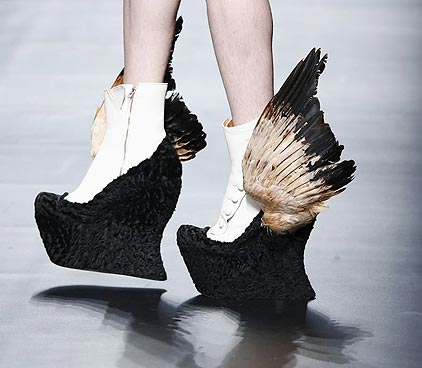
TOKYO (Reuters) - From a phoenix-themed collection by a Japanese designer who has clothed Lady Gaga to touches of traditional Mongolian decorations, designers showing at Japan Fashion Week set their sights firmly on Asia and its huge market.
Chinese consumers have become the world's leading buyers of luxury goods and account for one quarter of this market globally with demand growing, according to a report by consulting firm Bain & Co.
The fashion extravaganza showcasing the autumn and winter collections of 2013/14 kicked off at the weekend but Japanese brands took to the stage on Monday with Masanori Morikawa and his self-directed label, "Christian Dada".
Morikawa has created several pieces for American pop star Lady Gaga including a pink dress reminiscent of an origami crane for her 2012 "Born This Way Ball" tour.
This time he turned to Asia for inspiration with an edgy, androgynous collection titled "Fenghuang," which is Chinese for the mythical bird phoenix, pairing long, loose pants with richly embroidered lace on shirt sleeves for men and women.
Leather pants and jackets mingled with down-paneled trousers and shirts in plain, solid colors of black, white, red, blue and gold, which Morikawa said represented the nature of the phoenix.
"There's also the idea that the phoenix contains within itself both the male and the female, so we took this concept of fusion for the collection," Morikawa told reporters.
Asian influences came to the fore on Sunday as well as Mongolian designer Ariunaa Surenjav mixed modern designs with traditional raised forms on the shoulders and bunched sleeves.
"That part of the clothing design where the material goes up on the shoulder ... comes from the tradition in old Mongolia, where the local people who were noble and respected had that design," said Surenjav.
A NOD TO CHINA?
Although Morikawa said taking a Chinese title for the collection was just a reference to Chinese mythology and not a nod to the huge potential Chinese market, other designers were more open about their goals.
Conny Groenewegen, a Dutch designer who led off the runway on Sunday with clothing heavily influenced by Japanese designers, said her ambitions in Asia do not end with Japan.
"I would be very much interested to visit Shanghai and present my work over there, because I think that it is moving very fast," she told Reuters. "It's like a big youth culture over there and it has also a big, very rich history."
Although growth in China slowed last year, Bain is still forecasting growth of 4-6 percent a year for the global luxury market through 2015, after growth of 10 percent in 2012 to about $280 billion, largely driven by Chinese consumers.
With 1.3 billion consumers, many with a strong inclination for expensive brands that scream status, China remains a driving force in the luxury market.
Japan Fashion Week continues until March 24 with names such as Vivienne Tam and Hiroko Koshino also taking part.
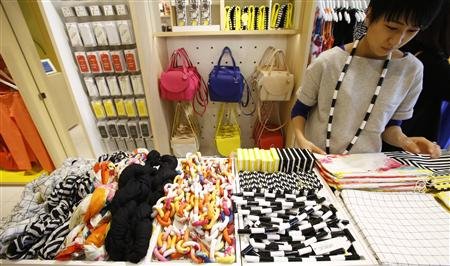
TOKYO (Reuters) - Given Kate Spade Saturday's bold designs, bright colors and creative flair, it was probably only fitting that the new lifestyle brand opened its first flagship store in fashion-obsessed Tokyo.
After all, the sister label of Kate Spade New York began developing the brand with Japanese consumers in mind more than three years ago, envisaging functional designs that would strike a chord with on-the-go urbanites and expand the original brand's DNA into a more casual realm.
Kate Spade Saturday opened its first store in Tokyo's trendy Harajuku district earlier this month and another in Osaka last week, and plans to have a total of five Japan stores open by June. Following the Japan launch, it also debuted in the United States via an online store and is eyeing a push into other international markets later this year.
"Because this brand's concept originated in Japan and we really wanted to make the brand global, we felt Tokyo was the perfect city to launch the brand," Ayako Yanagisawa, president of Kate Spade Japan, told Reuters in an interview at the company's offices in Harajuku.
"I think Tokyo is a very interesting city for the fashion industry to try out a new brand. The market is mature enough to receive, and digest, and understand new creativity. There is also a wide age range of people who like fashion in this city," she said.
"It can be a real showcase for the Asian market."
Tokyo has served as an overseas launch point in recent years for several brands, including designers Rebecca Minkoff and Tracy Reese. Both the Rebecca Minkoff and Tracy Reese brands showed at the Tokyo Runway fashion show Wednesday held in conjunction with Japan Fashion Week.
TRENDSETTERS
Kate Spade New York, owned by Fifth & Pacific Companies Inc, is known for the splashy colors and bold prints of its designer handbags, clothing and accessories. It competes with brands like Coach and Michael Kors in the attainable luxury category.
Kate Spade Saturday skews slightly younger, more casual, and less expensive than the New York label.
Yanagisawa said both the Japanese and U.S. sides of the company were involved in the development of the Saturday brand from the onset, and the design of several products reflects Japanese consumers' love for functionality and detail.
Its Half-Circle Bag, which goes for 19,845 yen ($210) online, can be worn over the shoulder or around the waist, and the strap can even be worn as a belt. Its Square Tote, at 17,325 yen ($180), has two side pockets that can be used to hold folding umbrellas - a must-have for Japanese urban life - or just as easily a bottle of wine to take to a party.
Japan is Kate Spade's biggest market outside the United States and the company aims to increase the number of its Japanese stores - including New York, Saturday and its Jack Spade men's brand - to between 85 and 105 in 2016, from 54 in 2012.
"The Japanese retail market still has room to grow," Yanagisawa said, noting that so-called fashion buildings, often built adjacent to or above train stations, were a big draw for women in their 20s and 30s even as traditional department store sales drop off.
Japan's young trendsetters are starting to take notice.
"Everyone has a Kate Spade iPhone case," said Kyoko Oyamada, a 21-year-old university student in Tokyo sporting a black leather Kate Spade handbag. "I thought they were cute so I went to check out the bags myself and found one I wanted."
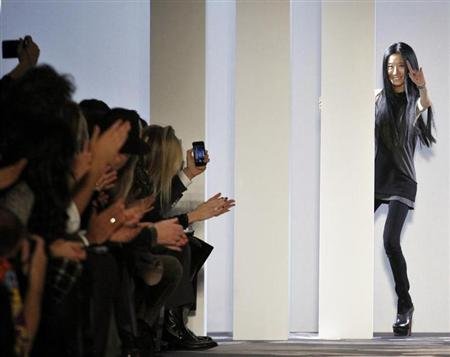
SHANGHAI (Reuters) - Vera Wang, the queen of bridal couture, is abolishing the nearly $500 fee she charged Chinese brides-to-be to try on a garment at her new Shanghai bridal boutique after the move, meant to deter counterfeiters, set off a global outcry.
Local and global media had criticized the surcharge as being discriminatory because it was applied only in China, at the company's Shanghai store, which staged a "soft opening" in January as the company's first bridal salon in the country, a vast potential market as the numbers of wealthy grow.
A Vera Wang spokeswoman told Reuters that the 3,000 yuan ($480) charge was being scrapped as of Wednesday.
"Please kindly be informed that Vera Wang has abolished appointment fees at her bridal salons worldwide starting from March 27, 2013," the spokeswoman said in an email, without elaborating.
A company spokeswoman told local media earlier this year that the charge was imposed to fend off copying of the elaborate dresses, which fetch thousands of dollars in the original.
Despite the move, though, Vera Wang's ivory tulle trains and pinched bodice gowns had already found fans in the world of pirates, with knockoffs widely available on Chinese e-commerce sites for a fraction of the price.
Li, one seller of "Vera Wang style" dresses on Taobao Marketplace, China's largest e-commerce site, says he can achieve up to 90 percent similarity to the namesake garments without even seeing the originals.
A Vera Wang original can range anywhere from $2,000 to over $10,000, but on Taobao some imitations go for as little as $100.
"For the experts you don't need to try on the dress to figure out how to copy it, you just need to see it or feel it at the shop," said Li, who declined to give his full name.
Li's factory, based in Suzhou, a city near Shanghai, makes Vera Wang knockoffs from photos of her creations, then sells them online for between 600 yuan ($97) to 1,700 yuan ($270).
The Taobao sellers who hawk the look-alikes use organza, satin and lace to recreate the ethereal bridal trains and three-dimensional floral whorls on Wang's dresses.
Most of the sellers online said they could achieve near 100 percent similarity to Vera Wang dresses but the complicated hand stitching and high quality materials that go into an original dress is something they can't replicate.
"There will be slight changes... If you want 100 percent you should buy the original," said one seller of mid-range copies.
In 2012, China was the top source country for counterfeit goods entering the United States and the European Union (EU) with more than 70 percent originating from China, according to the latest customs seizure reports from the U.S. and the EU.
Alibaba Group, which owns Taobao Marketplace, said in a statement to Reuters the company works with intellectual property rights holders to take down counterfeit listings and will penalize stores caught.

The Humane Society of the United States and The Art Institutes announced Johana Zara from The Art Institute of Vancouver as the grand prize winner of the seventh annual Cool vs. Cruel Fashion Design Competition.
Matthew Vice from The Art Institute of Dallas placed second, Golden Skyy from The Art Institute of Pittsburgh placed third and Melissa Hoffman from The Art Institute of California — Los Angeles received an honorable mention.
The Cool vs. Cruel Competition challenges Art Institutes students in fashion areas of study throughout the United States and in Vancouver to reinterpret and replace animal fur on runway looks by famous designers. This year's finalists were selected from among more than 200 entries.
"This program encourages fashion design students to make informed choices by educating them about the millions of foxes, raccoons and other animals who are killed every year for the fur trade," said Michelle McDonald, fashion outreach manager of the fur-free campaign for The Humane Society of the United States.
As grand prize winner, Zara will receive an expense-paid, weeklong internship in New York City with fur-free designer Victoria Bartlett. Bartlett has judged the Cool vs. Cruel competition for the past two years and was the recipient of The HSUS's 2010 Compassion in Fashion award. Zara earned the prize with her Fendi-inspired piece using long faux-fur, faux-suede and polyester chiffon.
"I'm amazed by the creativity of these future designers," Bartlett said. "I'm hoping that in the coming years, more designers will begin making compassionate choices and move away from the cruelty of fur."
Selecting the winners were designers John Bartlett, Victoria Bartlett, Marc Bouwer, Ally Chomer, Leanne Hilgart and Elizabeth Olsen; fashion photographer Nigel Barker; PAPER Magazine editor Mickey Boardman; and The Discerning Brute blog founder Joshua Katcher.
"This means a lot to me as I just decided to focus on fashion design this year," said Zara. "My passion for sketching and creating came out through this competition and winning makes me feel that design is the right route for me."
"Entering competitions such as this presents an amazing opportunity for students to learn and hone their craft," said Vice President of Academic Affairs at The Art Institutes, John Pufahl. "They gain practical, hands-on experience and can build their portfolios of work, which will prove beneficial when they enter the industry."
The Art Institutes is a system of more than 45 educational institutions located throughout North America. The Art Institutes schools provide an important source for design, media arts, fashion and culinary arts professionals. Several institutions included in The Art Institutes system are campuses of South University.
The Humane Society of the United States is the nation's largest animal protection organization — backed by 11 million Americans, or one of every 28. For more than a half-century, The HSUS has been fighting for the protection of all animals through advocacy, education and hands-on programs.

Nina McLemore, founder and CEO of Nina McLemore, Inc., a designer women's clothing company, announces the opening of her first New York retail store: 1023 Lexington Avenue at 73rd Street. There are 8 other company-owned locations: San Francisco, Seattle, Aspen, Cleveland, Nantucket, the New York Showroom and Chestertown and Easton, Maryland.
The other stores have proven the client demand, and Nina has now chosen to launch a store on the Upper East side of New York. While this is the Company's largest client base, most residents do not know of the showroom and many have asked for a store where they can bring friends to experience the collection and high level of service and product knowledge.
"There is a serious gap in the apparel industry for women who want chic, understated, elegant clothing for day through evening. At the Luxury end are high fashion runway collections from international designers and at volume prices are contemporary collections for young women from 15 – 30. My collections are based on quality fabrics and tailoring, a sense of style and a strong feminine image, not provocative fashion trends."
Nina founded the collection after a successful career in the apparel and accessories industries to fill this underserved niche in women's apparel. Nina understands the needs of successful executive women and "community professional" women who have limited time to shop, travel extensively and are looking for clothing to serve multiple purposes.
The collection includes luxurious natural fabrics that are expertly crafted primarily in the U.S. The designs are focused on quality, taste, vivid colors, and attention to detail coupled with a superb fit. Sizes range from 0 to 18. The company's clients love wearing the clothes, the many compliments they receive, and they feel as if they are part of a private exclusive club who collect and treasure their "Nina's".
By selling directly to the client the collection offers European fabrics and designer tailoring at prices under $1,000. The company's direct to consumer and multi channel approach to distribution is a unique business model. Distribution is through the company-owned free-standing stores, select better specialty stores, company website and directly to women in private trunk shows by sales consultants who own their own business and who provide outstanding service.
Nina McLemore is a designer and a successful businesswoman who is determined that her company become the leader in serving the needs of women in this market segment. Nina founded Liz Claiborne Accessories in 1980 and led the trend for designer accessories.
She served on the Executive Committee of Liz Claiborne, Inc., co-founded a private equity firm and was previously VP GMM of May Department Stores International. Growing up in Mississippi, Nina designed and made her own clothes. Her lifetime passion for creating clothing that gives a woman a tasteful, fun image and her passion for community service is rooted in these early years.

Agria Corporation, a China-based company with investments in the agriculture sector, announced that its New Zealand listed subsidiary, PGG Wrightson, is to establish a Beijing representative office.
The Beijing representative office will work to deliver revenue and profit-generating business for PGG Wrightson in China. The initial focus will be on working with PGG Wrightson existing businesses to satisfy the strong demand in China for high quality grass seed and for dairy livestock sourced from New Zealand, Australia and Uruguay.
It is envisaged that the representative office will facilitate sourcing of products for PGG Wrightson's rural supplies business in New Zealand and serve as a valuable resource for PGG Wrightson's other business units. The office will also be responsible for conducting market and product research, marketing, brand promotion and coordination of PGG Wrightson's activities in China, amongst other activities.
Xie Tao, Agria's Chief Executive Officer, said Agria is proud to welcome its partner into China. "The establishment of a formal representative office reflects the success of our relationship, our resource sharing and continued mutual goal of pursuing attractive growth opportunities in China, New Zealand and worldwide."
George Gould, Managing Director of PGG Wrightson, said the move represented a significant milestone in the company's strategy of generating value for all PGG Wrightson shareholders from market opportunities in China.
"It is worth noting that PGG Wrightson has a history of working with China-based partners and customers given the international scope of our livestock, wool and proprietary seeds businesses."
Mr. Gould will be visiting Beijing as part of a scheduled business trip to China later this week.
Agria Corporation is a China-based agriculture company with operations in China and internationally. In China, we engage in research and development, production and sale of seed products, including field corn seeds, edible corn seeds and vegetable seeds.
PGG Wrightson is a leading provider to the agricultural sector offering a wide range of products, services and solutions to growers, farmers and processors in New Zealand and internationally.
Within the site, you will find information on all the products and services we offer to help you maximise your agri-business profitability.
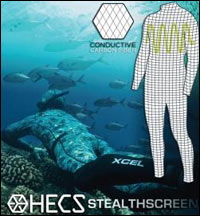
HECS, a global leader in concealment textiles headquartered in Oregon, announces its partnership with Xcel in developing wetsuits that will enable divers to get closer to marine life. Leading international wetsuit brand Xcel will release HECS STEALTHSCREEN fullsuits, which feature cuttingedge concealment technology designed to give divers greater proximity to underwater marine life than ever before.
Already proving it’s efficacy in the hunting community, HECS STEALTHSCREEN technology material is endorsed by the Pelagic Shark Research Foundation, Santa Cruz, California.
Mike Slinkard, President of HECS LLC, says the relationship with Xcel is a natural progression for the HECS technology. "HECS STEALTHSCREEN has major benefits to divers," says Mike.
"All living things, including humans, emit faint electric signals. Many marine species are able to detect and react to these signals. HECS STEALTHSCREEN reduces the human electric signal, allowing divers to experience life underwater in its natural undisturbed state."
"The unique HECS STEALTHSCREEN material is incorporated into the Xcel wetsuit as an inner lining made of conductive carbon fibers that are designed to reduce the human body’s electric signal, while delivering the highest standards of comfort, performance, and flexibility for which Xcel wetsuits are known."
Xcel’s HECS STEALTHSCREEN fullsuits are available in multiple thicknesses, including camouflage-patterned colors for greater visual concealment in underwater environments.
HECS is a world leader in concealment technology. An Oregon-based company, HECS also supplies apparel and equipment to the hunting industry. HECS STEALTHSCREEN’s conductive carbon grid works to reduce the electric signal emitted by the human body.
Founded in 1982, Xcel International Inc (Xcel) is a global brand distributed throughout the Americas, Europe, Asia, and the Pacific Rim. Headquartered on the North Shore of Oahu, Hawaii, Xcel’s core wetsuit business focuses on the cutting edge of material and design development.